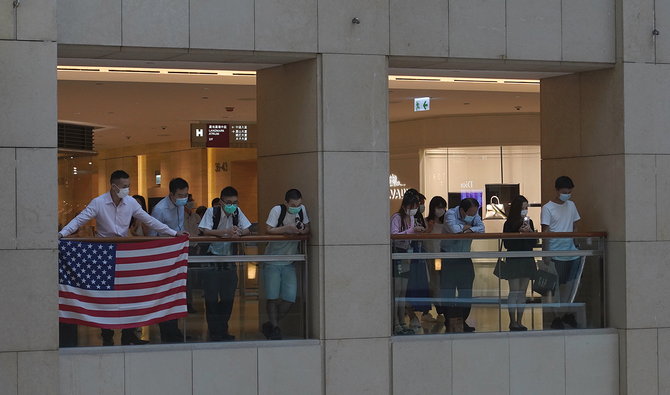
- ARAB NEWS
- 12 Jul 2025

The world economy is just starting to re-emerge from a COVID-19 lockdown but it may be faced with an ill-timed tug-of-war between the US and China, which has Hong Kong being pulled from both sides. At this stage of the conflict, all three players stand to lose out.
This latest dispute was triggered by Beijing’s less than stealth maneuver during the National People’s Congress to pass controversial legislation which would give it greater sway to impose security measures on the territory. Without hesitation, Washington weighed into the debate by calling for a review of its Hong Kong Policy Act to assess the level of territory’s autonomy from China.
US President Donald Trump said that he will begin the process of removing the preferential status for Hong Kong in retaliation for China’s move. With no clear timeline articulated and the overwhelming challenge of nationwide protests in America, investors expressed some relief that a “clear and present danger” has been avoided. However, it would be a mistake in an US election year to assume that this issue will slide off the agenda.
US Secretary of State Mike Pompeo said that the island no longer maintains the freedoms that were afforded it after the 1997 handover from the UK to China. “No reasonable person can assert today that Hong Kong maintains a high degree of autonomy from China, given the facts on the ground,” the top US diplomat declared.
Removing that preferential treatment would be viewed as hostile act against Chinese President Xi Jinping. Immediately after Pompeo’s comments, Beijing drew its own line in the sand.
“Internal and external hostile forces are trying to use Hong Kong to split the country, subvert the government, carry out terrorist acts and interfere in the affairs of Hong Kong,” said an official statement from China’s embassy in Washington. It went on to conclude that Beijing will continue implementation of the “one country, two systems” policy.
The Trump administration has made it a policy priority to maintain pressure on China to reverse what was a $419 billion trade deficit in 2018. Huawei, the telecoms equipment manufacturer, remains a bone of contention, with the White House eager to get allies to stop orders of the group’s 5G technology, which Washington claims is used as a Trojan horse for intelligence purposes.
The two sides applied tariffs and counter-tariffs. The trade deficit shrank to under $350 billion last year with those tariffs in place, but so too did global growth. Trump and Xi agreed to find common ground with a face-saving pledge for China to purchase an additional $200 billion of goods. The agreement covers farm products, natural gas and scores of other items, which would play well with the president’s base in the heartland of America during an election year if they are delivered.
It does not look promising as the two lock horns on numerous issues.
White House economic adviser Larry Kudlow recently said that the US president is giving that deal less importance and that the administration remains “miffed” with Beijing over the coronavirus.
With Wuhan labelled as ground zero for COVID-19, it opened Beijing to a full range of accusations by the Trump administration, which included hiding evidence, silencing the World Health Organization and developing the virus in a medical research lab there. Critics of the Trump administration contend it was an effort to deflect attention from the president’s initial denial of the coronavirus and his subsequent slow response to the threat.
Which leads us back to Hong Kong. For centuries under British rule, the territory developed as a vibrant trade and financial services hub. Prior to the handover, the city state was known for its press freedoms, sound judicial system and favorable tax regimes that welcomed global companies to use it both as a regional hub and a springboard into China. This rings true for American companies as well. According to the US Consulate General in Hong Kong, 1,200 are doing business there and two-thirds make it their regional headquarters. Carrie Lam, Hong Kong’s chief executive, who has always towed Beijing’s policy line, claims the measure would have only limited scope to curtail protests and provide a semblance of stability to restore growth.
If Washington goes ahead in earnest with what many say is the “nuclear option” by removing the preferential status, the signal is loud and clear to US companies; it’s time to rethink your presence there. The US feels with its diplomatic clout the fallout will reach far beyond American companies. It ranked third in the World Economic Forum’s annual “Global Competitiveness Report” last year, a top-ranked status it has enjoyed since the survey was developed.
But perhaps Beijing’s bold move to play its own trump card with security legislation may be signaling its overall frustration after two years of protests. If it cannot contain a middle ground of limited democracy and civil liberties, then its own financial hub of Shanghai may be given an expanded role.
In the meantime, strained US-China relations will be a deterrent to a global recovery and Hong Kong’s business brand will most certainly suffer another blow.
• John Defterios is CNN Business Emerging Markets Editor and host of The Global Energy Challenge on CNN International.